‘What I love about baking is that it straddles being rules-based and creative,” says Rachel Stonehouse, head of training at Luminary Bakery. “There are lots of skills to learn – timekeeping, following instructions, working efficiently; things that can be transferred to whatever job people do.”
Stonehouse is also co-author of the Luminary cookbook, Rising Hope, which showcases recipes and stories from the more-than 50 students who have so far completed the bakery’s training programme. Though the book deals sensitively with the details, it’s clear the graduates have succeeded despite coming from the darkest edges of domestic and financial instability.
Through her volunteer and social work, founder Alice Williams met women who were living on the street or in precarious accommodation. They lacked CVs and opportunity – no one was willing to employ them, and they couldn’t move towards a new, stable life.
“These women were stuck in their circumstances,” says Williams. “Tangible employment was the starting point, but when we began a very small bakery we realised the women were a long way from being able to function in [a work] environment, so we developed the training programme to help them.”
Stonehouse joined Luminary at the start of the training programme, six years ago when she was 18. What was going to be a gap year turned into a gap life, she laughs. She trained as a pastry chef while training women in the programme, passing on her passion and newly learned skills: “The programme evolves as we do.” It’s been a rapid ascent from sharing kitchens in churches and community centres to having two London sites – Stoke Newington opened in 2016 and Camden in 2019. Students are with Luminary for six months: one day of baking a week, plus group learning in communication, time management, managing emotions and resilience. They have access to core workers for individual support, to help with areas such as housing and childcare, and that continues for at least 18 months.
“We put a strong focus on access to work because that’s the key to unlocking so many other doors,” explains Williams of the holistic approach. “But in order to get and sustain a job, maybe your first job, when you’re overcoming so many other things in your past, including trauma, other areas of life need support to give you the best help succeeding.”
Diagnosed with PTSD in late 2017, Sarah tried various anxiety relief techniques but became increasingly disheartened when they didn’t help. “Then I baked a victoria sponge, and it was the first time I’d let my mind have a break.”
Attracted by the baking and the all-women environment, she was soon in the Luminary programme. “They encouraged me so much.” Sarah is now a teaching assistant on Luminary’s employability programme, and runs a cake business that promotes positive mental health: her white chocolate and pistachio cake is included in the book.
Graduates get work experience and paid opportunities in the Luminary bakeries. Some go on to study patisserie at advanced levels, others start their own small bakeries, while a high proportion have chosen to go into education – including running baking workshops at their kids’ schools.
At the end of the training, graduates create a recipe to celebrate. Quite a few were so memorable that they’ve been included in the book. Others have come from the cafe menu, including the byreks, which were originally brought in as a treat for the staff.
“This feels like a book that’s been brought together by a community of women,” says Stonehouse, “and all the recipes that they’ve carried through our doors and left with us.”
Sarah’s pistachio, blackberry and white chocolate layer cake
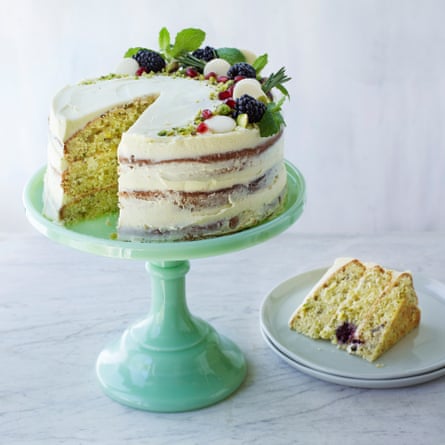
Sarah came to Luminary after discovering baking as a form of therapy while she struggled with a diagnosis of post traumatic stress disorder. This cake was one of the first creations she made.
As a Luminary graduate, a staff member and now a business owner, Sarah has been unstoppable in sharing her story of recovery and using it as encouragement for others.
“I started baking to help get out of my own head. Even if it was just for five seconds, I finally had a moment of peace.”
Sarah’s cake is a delicious way to bring people together. It suitably weds the pop of fresh blackberry with the light pistachio sponge, making it perfect for any celebration.
Serves 10-12
unsalted butter 330g, softened, plus extra for greasing
caster sugar 220g
eggs 6 medium
self-raising flour 330g, plus extra for dusting
whole milk 100ml
vanilla extract 1 tsp
unsalted pistachios 100g, finely chopped
blackberries 100g, fresh or frozen
For the buttercream
white chocolate 150g, broken into pieces
unsalted butter 150g, softened
icing sugar 250g
vanilla extract ½ tsp
To decorate
unsalted pistachios a mixture of whole and finely chopped
fresh blackberries some whole, some cut in half
white chocolate buttons
sprigs of fresh rosemary
fresh mint leaves
pomegranate seeds
Preheat the oven to 160C fan/gas mark 4. Grease and line the base of 3 x 20cm tins with baking paper. Dust the greased edges of the tins with a little flour, tapping out any excess.
In a large bowl, cream the butter and sugar together with an electric mixer until light and fluffy. Mix in the eggs, one at a time, until fully incorporated. Mix in half of the flour, then half of the milk, mixing until no floury or milky patches remain, before adding the remaining flour and milk. Mixing on a low speed, add the vanilla extract and pistachios until incorporated.
Carefully fold the blackberries into the batter by hand, to avoid the mixture turning an unappetising blue-grey colour from the juices they can release.
Divide the batter evenly between the lined tins. Bake for 20-25 minutes until the sponges spring back to the touch and an inserted skewer comes out clean.
Leave to cool in the tins for 10 minutes before gently turning the sponges out onto a wire rack to cool completely.
To make the buttercream, melt the white chocolate by placing it in a bowl set over boiling water (don’t let the base of the bowl touch the water). Alternatively, gently melt it in a microwave, being careful to stop and stir it every 30 seconds to avoid burning.
In a large bowl, beat the butter for 1-2 minutes, then gradually add the icing sugar, a spoonful at a time, mixing it in before adding the next. Once all of the icing sugar is incorporated, mix in the vanilla and melted white chocolate.
When the sponges are completely cool, trim the domed tops off with a bread knife to make them flat.
Place a cake board or serving plate on a turntable or work surface and smear a little buttercream on the top. This buttercream will act as “glue” and stop the cake from sliding around. Peel off the baking paper from the sponge layers and place the first sponge layer, cut-side up, on the board or plate. Spread a quarter of the buttercream on the top of the sponge, pushing it just over the edge.
Place a second sponge layer on top of the buttercream, cut-side down. Spread another quarter of the buttercream on the top of this layer, pushing it just over the edge. Place the third sponge layer on top, cut-side down. Spread another quarter of the buttercream on the top, pushing it just over the edge. Spread the final quarter of the buttercream around the sides of the cake, until the whole cake is covered in an even layer of buttercream and any gaps are filled.
Place a bench scraper at a 90-degree angle against the side of the cake and turn the turntable (or your plate) to smooth the sides flat and create a patchy or “naked” look to the icing on the sides of the cake. (Don’t worry if you push some buttercream on to the top of the cake.)
To finish the cake with a smooth, 90-degree angle on the top, use a palette knife to neatly drag the top edge of buttercream into the middle of the cake.
Decorate the top of the cake with a Luminary crescent moon shape using all of the decoration ingredients. First, sprinkle the finely chopped pistachios into a moon shape, tapering off the ends – this will be your guide for the rest of the toppings. Place the blackberries in the shape, with the whole ones at the widest section of the moon and the smaller pieces towards the ends. Repeat with the whole pistachios and white chocolate buttons. Finish by placing small sprigs of rosemary and mint leaves in among the fruit and use more chocolate buttons and pomegranate seeds to fill in any gaps.
Tanya’s banana fritters with cinnamon sugar

Although contentment was a rarity in her childhood home, happy memories of being in the kitchen with her mother have helped Tanya when life hasn’t been kind.
After a traumatic attack in which Tanya barely escaped with her life, she became more determined than ever to seek restoration. She found this Jamaican recipe, among many others, to be therapeutic during her recovery.
Tanya was eventually introduced to Luminary. Over the period of the course she was inspired by the resilience of the women she met.
Today, cooking and baking has become a means for Tanya to inspire hope in those who have undergone similar life-changing experiences. Food has a significant way of bringing people together. Tanya’s tip is: “Always cook with love.”
This was one of the first Jamaican recipes Tanya learned and she has fond memories of being in the kitchen with her mother as the aromas of sweet banana and cinnamon sugar filled the room.
Serves 4 (makes about 16)
medium bananas 3 (about 330g peeled weight)
freshly grated nutmeg ⅛ tsp
ground cinnamon ½ tsp
vanilla extract 1 tsp
soft light brown sugar 40g
plain flour 160g
baking powder ½ tsp
fine salt a pinch
vegetable or sunflower oil 4 tbsp, or more as needed, for frying
For the cinnamon sugar
caster sugar 120g
ground cinnamon 1 tsp
To serve
yogurt or vanilla ice-cream dairy-free, if you like
In a medium bowl, mash the bananas until they are creamy with just a few small chunks remaining. Stir in the nutmeg, cinnamon, vanilla extract, light brown sugar and 4 tablespoons of water until combined. Sift the flour, baking powder and salt over the mixture and mix in until you have a thick batter.
Make the cinnamon sugar by stirring together the caster sugar and cinnamon in a shallow bowl and set nearby.
Heat the oil in a large non-stick frying pan over a medium heat. To test when it’s hot enough for frying, add a small dollop of the batter to the oil and watch for it to sizzle and brown. When it’s hot enough, carefully drop tablespoons of the banana batter into the pan, swirling the oil over them as they spread out. It’s best to fry no more than 5-6 fritters at a time so you don’t overcrowd the pan. Fry for 3-4 minutes on each side until the fritters are a dark golden brown. Lift them out of the pan with a slotted spoon and drain on paper towels for 30 seconds.
Add a little more oil to the pan if needed, and repeat until all the batter is used up.
Tip the still-hot fritters into the cinnamon sugar and turn to coat on every side. Serve immediately, still warm from the pan, with a dollop of yogurt or a scoop of vanilla ice cream.
Our signature cinnamon swirls with cream cheese frosting
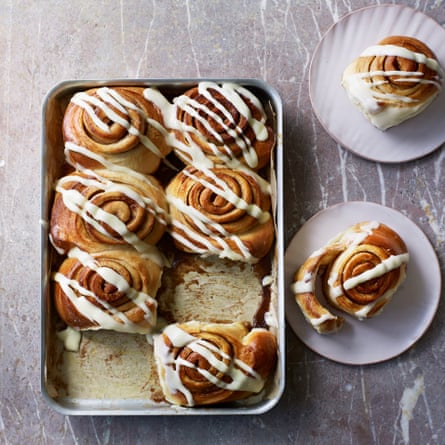
These large, gorgeously swirled cinnamon buns are one of our most popular bakes. In our very first kitchen, we’d pile them high into large boxes and carry them on the tube across London to cafes.
Makes 8 large buns
For the dough
strong white flour 675g, plus extra for dusting
caster sugar 70g
fine salt 1½ tsp (7g)
fast-action dried yeast 3¼ tsp (10g)
egg 1 medium, beaten
whole milk 400ml, warmed to lukewarm
unsalted butter 70g, softened
For the filling
unsalted butter 150g, softened
soft light brown sugar 75g
golden syrup 75g
ground cinnamon 1 tbsp
For the frosting
unsalted butter 50g, softened
cream cheese 100g, at room temperature
icing sugar 200g
vanilla extract ½ tsp
To make the dough, combine the flour and sugar in a large mixing bowl. Add the salt to one side of the bowl and the yeast to the other, making sure they don’t touch. Toss the salt in some of the flour surrounding it and do the same with the yeast, finally mixing them all together until combined. (If the yeast comes into direct contact with the salt it can retard it and stop the buns rising.)
Weigh out 25g of the beaten egg (about half – reserve the other half for an egg wash later) and mix into the warm milk. Make a well in the middle of the flour, pour in the milk mixture and use a butter knife or bench scraper to bring it together into a soft ball of dough. Get your hands involved, kneading it in the bowl before tipping it out on to a clean work surface.
Knead the dough for 10 minutes, using a bench scraper to keep the surface clean. Avoid dusting it with extra flour (this will give you hard, tough buns). It will be very sticky so try slapping it on the work surface and folding it over repeatedly, to keep it from covering every inch of the surface. Alternatively, use an electric mixer fitted with a dough hook to do all the messy kneading for you.
Add the butter to the dough and knead for a further 5 minutes until glossy and still slightly sticky to the touch. Try the “windowpane” test to be sure it’s ready. Return the dough to the mixing bowl, cover with a damp tea towel or clingfilm and leave somewhere warm to prove until doubled in size (1½-2 hours).
Meanwhile, make the filling. In a bowl mix the butter, sugar, syrup and cinnamon into a smooth paste using a wooden spoon or spatula. Spread about 2 tablespoons of the mixture over the base of a 30cm x 24cm x 5cm baking tin and set aside.
Once the dough has proved, knock out the excess air by squashing and punching it back into the bowl a few times. Scrape the dough out on to a very well-floured work surface and use a floured rolling pin to roll the dough out into a 60cm x 30cm rectangle, about 2cm thick. Evenly spread the remaining filling mixture across the dough, right to the very edges.
Find the shortest edge of dough and fold over 1cm of it, then continue to gently roll the dough up into a tight swirl, using your fingers and thumbs to work from one side to the other. Roll it as tightly as possible. You should be left with a dough sausage about 30cm in length.
Mark out, then use a very sharp knife to cut the sausage of dough into 8 even slices. Place the slices, swirl-side facing up, on the cinnamon-smeared baking tin, spacing them about 2cm-3cm apart. Leave somewhere warm for 40-60 minutes to prove a second time, covered with a damp tea towel or clingfilm. They should have doubled in size and started to touch one another.
Meanwhile, preheat the oven to 180C fan/gas mark 6.
Brush the top of each swirl with the remaining beaten egg, then bake for 20-25 minutes until golden brown. Once baked, transfer the tin to a wire rack and let them cool completely in the tin.
To make the frosting, beat together the softened butter and cream cheese with an electric mixer or spatula until smooth. Add the icing sugar in 3 stages, mixing in each third before adding the next. Once it’s smooth and creamy, mix in the vanilla extract. Spoon the frosting into a piping bag and pipe zigzags over the top of each cooled bun. If you don’t have a piping bag, don’t worry – you can use a spoon to drizzle or smear the frosting over the tops of the buns instead. Enjoy!
Anna’s spinach byrek
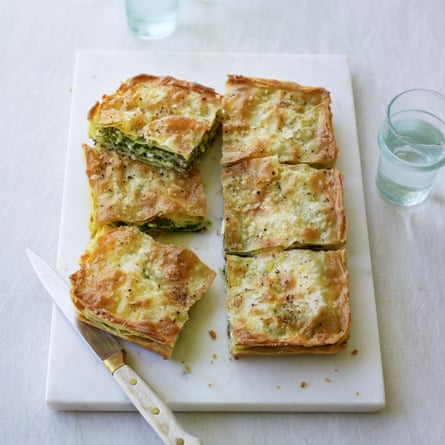
Anna* is always our go-to for pastry. With an Albanian upbringing that meant she mastered the intricate delicacy of pastry from an early age, we’re forever grateful to her for introducing us to her impressive spinach byrek.
Anna made her very first byrek at the age of 12, after watching her mum make them for years. She remembers the challenge of stretching the dough to an exquisitely fine layer and how the scent of white onions filled the house. It all came together for the end result of delicious and perfectly flaky byrek.
As the years passed, Anna had some painful, life-changing experiences and decided to move to the UK for a fresh start. After a recommendation from a support worker, she discovered Luminary Bakery, and we’re so glad she did.
Anna says: “I wanted to learn, because when I came to this country I didn’t know a lot, not even English. But I wanted to change our lives for the better. After coming to Luminary, I started to accept that maybe I could do it. And now, I dream!”
Byrek are delicious Albanian flaky pastries stuffed with a savoury filling. Anna’s family recipe is at the heart of this version, but with her own twist: a spinach and feta filling with cracked black pepper on top. These are perfect at any time of the day.
*name has been changed
Makes 6-8
For the pastry
extra-strong high protein plain flour 300g, plus extra for dusting (we use Aytac flour or Canadian high-gluten flour)
fine salt 1 tsp
sunflower or vegetable oil 1 tbsp
ghee 50g, melted, for brushing (or use salted butter)
For the filling
ghee 25g
sunflower or vegetable oil 4 tsp
fresh spinach 300g
feta or crumbly sheep’s cheese 300g
salt and cracked black pepper to taste
Start with making the pastry. Mix the flour and salt together in a large bowl, then make a well in the middle and tip in the oil and 220ml warm water. Use a wooden spoon or bench scraper to bring it together into a dough, eventually kneading it together with your hands.
Tip the dough out on to a clean work surface and knead it for 10 minutes until it’s really stretchy and elastic. Put the dough back into the bowl, cover with clingfilm or a damp tea towel and leave to rest for 1 hour.
Meanwhile, make the filling. Melt the ghee and oil in a large pan over a medium heat. Add the spinach and gently cook down until wilted and most of the moisture has been cooked off. Remove the pan from the heat and stir in the crumbled cheese. Taste the mixture and season with salt and pepper to taste.
Preheat the oven to 170C fan/gas mark 5 and grease the base and sides of a 20cm x 25cm baking tin with melted ghee.
Lightly flour a clean work surface and rolling pin. Turn the dough out of the bowl and cut it into 6 equal pieces. Taking one piece at a time, roll and stretch each one out as thin as you can using the rolling pin and your hands – the dough should be thin enough to read newspaper print through it. If it starts to stick, lift it up and dust more flour underneath.
Cut the dough into rectangles the same size as your tin. Collect any scraps so you can re-roll them and make as many sheets as you can. Layer a third of the pastry rectangles in the tin, brushing each one with melted ghee before laying the next one on top. Spoon half of the spinach filling on top of the pastry stack and spread it out to make an even layer.
Layer the next third of the pastry rectangles on top of the spinach, again brushing with melted ghee between each layer. Top with the second half of the spinach filling and spread it out flat.
Layer the final third of the pastry on top, brushing melted ghee between each layer as before. Brush the very top layer with the last of the ghee and sprinkle with cracked black pepper.
Bake for 30-35 minutes until deep golden brown on top. Leave to cool, then remove from the tin and cut into 6-8 large squares.
Giselle’s lemon and poppy seed cotton cake
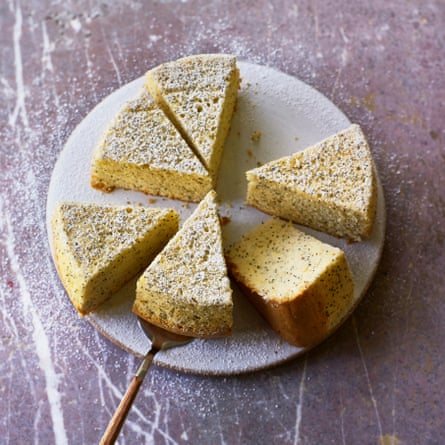
Life before prison was a battle for Giselle. When she was released, she was determined to turn her life around. The art of preparing food for others is strong within Giselle’s heritage – with a baker for a grandad and talented cooks for parents. Luminary has now become a home for Giselle – a network of women supporting each other. She says, “The most inspirational factor among these women is strength of character and perseverance. They are a constant reminder to me that we are all warriors.”
Inspired by a Japanese vanilla cake, Giselle adapted this recipe so that the clean and light flavour of lemon complements its delicacy. Pair it with a cup of earl grey tea.
Serves 8-10
unsalted butter for greasing
eggs 4 medium
white granulated sugar 80g
lemon extract 1½ tsp
lemon 1 large (or 2 small), finely grated zest and a squeeze of the juice
vegetable oil 65ml
whole milk 70ml, or a dairy-free substitute, such as oat or almond
plain flour 120g
baking powder 1 tsp
poppy seeds 30g
icing sugar for dusting
Preheat the oven to 140C fan/gas mark 3. Grease and line the base and sides of a 20cm cake tin (not a loose-bottomed one) with baking paper, ensuring the strip around the side reaches at least 5cm above the top of the tin. Wrap the outside of the tin with foil.
Separate the egg yolks from the whites, placing the yolks in a medium mixing bowl and the egg whites in a large grease-free mixing bowl. Whisk the egg yolks with half of the sugar until pale and light. Add the lemon extract, lemon zest, oil and milk and gently stir to combine. Sift the flour and baking powder over the mixture and stir until just combined, being careful not to over-mix.
Whisk the egg whites with the squeeze of lemon juice and the remaining sugar until it forms stiff peaks when the beaters are lifted sharply out of the bowl. This should take about 5 minutes with an electric whisk.
Gently fold half of the egg whites and all of the poppy seeds into the batter, then pour the batter into the remaining egg whites, scraping down the sides of the bowl. Gently fold and mix until there are no lumps of egg whites left, being careful not to knock out too much air.
Spoon the mixture into the prepared tin and gently spread flat. Place the tin into a water bath (fill a roasting tray with enough boiling water to reach three-quarters of the way up the sides of the tin). Bake for 25 minutes, then turn the oven up to 160C fan/gas mark 4 and bake for a final 10 minutes.
Once baked, carefully remove the tin from its water bath and bang the tin sharply on the work surface a couple of times (this will help prevent the cake shrinking). Allow the cake to cool in the tin for 30 minutes before turning out on to a serving plate.
Lightly dust the top with icing sugar to serve.
Mim’s vegan chocolate and sea salt cookies
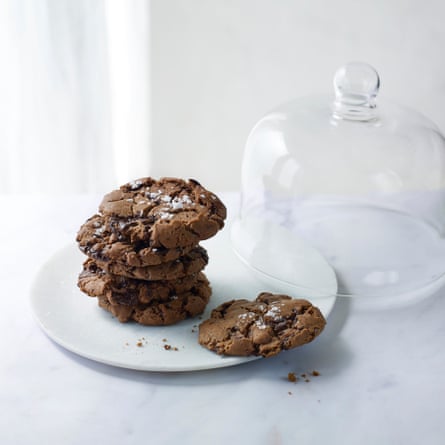
When Mim joined us, she not only brought a wealth of cake-decorating experience and a kind and caring spirit, but a passion for making exquisite vegan bakes. Mim says this recipe is inspired by all the women she has worked with in the kitchen over the years.
Makes 15
olive oil 115ml
soft light brown sugar 210g
vanilla extract ½ tsp
plain flour 250g
cocoa powder 30g
baking powder 1 tsp
bicarbonate of soda ¾ tsp
fine salt ¼ tsp
vegan (70%) dark chocolate chips 175g, or a bar cut into 1cm chunks (check to ensure it is dairy free)
flaky sea salt
Mix the oil, sugar and vanilla extract together with 60ml of cold water until thoroughly combined and it looks like caramel. In a separate bowl, sift together the flour, cocoa, baking powder, bicarbonate of soda and salt.
Tip the dry ingredients into the wet ingredients and mix to fully combine and create a soft dough. Add the chocolate chips and mix until equally distributed. Cover the bowl with clingfilm and chill in the fridge for 30-60 minutes until firm.
Preheat the oven to 160C fan/gas mark 4 and line 2 x large baking trays with baking paper.
Use a dessertspoon to scoop balls of dough on to the trays, spacing them 5cm apart to allow for spreading. Alternatively, weigh out balls of dough at 55g each, and roll them in your hands before placing on the trays. Top each cookie with a pinch of sea salt flakes.
Bake for 10-12 minutes until the cookies have firmed up around the edges. Leave to cool on the trays for 5 minutes before transferring to a wire rack to cool completely.
Rising Hope: Recipes and Stories from Luminary Bakery by Rachel Stonehouse and Kaila H Johnson, with Alice Williams and Rachael Coulson (Harper Collins, £20) is published on 20 August